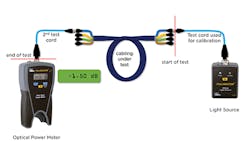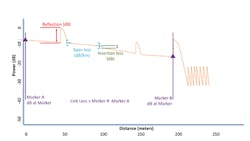Understanding Tier 1 vs. Tier 2 Fiber Optic Certification:
Unlike copper cabling where only 1 level of certification is defined by standards, there are 2 levels, or tiers, available when certifying fiber optic cabling. The different tiers specify which type of tests are performed during testing, and therefore define the test equipment to be used, known as Tier 1 or Tier 2 certifiers.
Tier 1 Certification Explained
Tier 1 certification is a measurement of the total insertion loss (previously called attenuation) of the cabling from one end of the link to the other. The equipment used to perform Tier 1 certification is an optical power meter and optical light source. (An OLTS (optical loss test set) is an advanced type of PM/LS with additional capability. In this article, OLTS will be used to refer to both OLTS and PM/LS testers.)
Tier 1 Certification Detail
• Tier 1 certification uses an optical light source and optical power meter to measure the total insertion loss across the cabling under test so that the tester will provide 1 number that is the sum loss of all the "events" in the cabling connected to the tester. Events are components of the optical cabling link that either lose or reflect light as it passes through. Events include cable, connectors, bulkheads, splices, splitters, and bends/kinks.
• Tier 1 is a simple and accurate way of determining whether a fiber optic link will support an application or not. The resulting insertion loss measurement can be compared to a specification or standard to provide a pass/fail status of each link for its intended use. As mentioned above, if 100GBASE-SR10 Ethernet allows a maximum channel loss of 1.50dB, a channel that exceeds 1.50dB of loss will fail the test and a channel with 1.50dB loss or less will pass. It is a simple, quick go/no-go test, and is the most common method of certifying fiber optic cabling.
• To perform Tier 1 certification, the test cord(s) used for testing with the PM/LS are first referenced/calibrated out so that their loss is not included in the test results. There are different reference methods available, using either 1, 2, or 3, test cords. The method used depends on several factors including the type of PM/LS used for testing. In this article the single test cord or "1 jumper" method will be referred to because it is recommended by both the ANSI/TIA and ISO/IEC standards organizations. The primary reason that OLTS testing is the preferred method of testing insertion loss is that it is a very accurate, direct measurement of power loss in the link. With Tier 2 certification insertion loss is calculated, not directly measured by the OTDR, leading to potential differences in the reported insertion loss between the 2 instruments. The OLTS is always the most accurate method of measuring insertion loss of a link, even though an OLTS can cost significantly less than an OTDR. (See Figure 1.)
Figure 1. An OLTS is a simple measurement where a known level (brightness) of light is injected into one end of the link and the level leaving the link at the other end is measured. The difference between the 2 values is the link loss.
Tier 2 Certification Explained
Tier 2 certification provides loss information about each component of the link. An optical time domain reflectometer (OTDR) is used to perform Tier 2 certification. The primary advantage of a Tier 2 test is that it provides information about each connection, splice and cable segment in the link and offers a graphical representation of the components and their performance. When testing newly installed cabling, the report is a snapshot of the system that can be compared to later tests to identify any changes in the cabling. An OTDR is unrivalled for troubleshooting because it shows the operator exactly where faults are in the cabling, expediting the repair process.
Tier 2 Certification Detail
• Tier 2 certification is not a substitute for Tier 1 certification but is performed in addition to Tier 1 certification when further information about the link is desired.
• Tier 2 certification uses an OTDR to characterize the link under test by measuring each of the individual components that make up the entire cabling. An OTDR creates a visual representation of the link allowing the operator to see the contribution of each component to the link’s total loss, making it a perfect tool for troubleshooting. Previously OTDRs were used only for troubleshooting in LANs because of their cost and complex operation. Today, OTDRs are very easy to use, and the costs have come down to a point where it is practical to use them for initial turn-up testing.
• By certifying new cabling with an OTDR, a snapshot is created documenting the location and performance of every component at the time of installation. Should an issue arise later, a current OTDR test can be compared with the initial test to immediately identify what has changed in the cabling and the location of that fault.
• Before diving into the operation of an OTDR, one should understand the measurements it performs during a test. An OTDR classifies everything it "sees" as 1 of 2 categories of event: attenuation/non-reflective events or reflective events.
• Attenuation events are those where power is lost going through the event and none is reflected to the OTDR. Events that fall into this category are fusion splices, micro bends, macro bends, and the fiber optic cable itself.
• Reflective events are those where power is lost going through the event, and power is reflected to the OTDR. Events that fall into this category are connections/bulkheads, mechanical splices, breaks in the fiber, and the end of the fiber optic cable. (See Figure 2.)
Figure 2. Sample OTDR trace with measurements for connector reflection, splice loss, cable span loss, and end-to-end link loss.
Tier 1, Tier 2, or Both?
Two of the most commonly asked questions regarding the types of certification are: 1) which type of test should be used, and 2) whether performing Tier 2 certification meets the requirements of Tier 1 certification.
Ultimately, the required testing is an agreement between the cabling contractor and their customer. However, when certification is required, it is good practice to always perform a Tier 1 test and optionally do a Tier 2 test. Tier 2 certification supplements Tier 1 certification; it is not a replacement for it. This often confuses people because in addition to the losses for each component in the link, an OTDR will show the total link loss like an OLTS does. So why then does an OTDR not satisfy the requirement for Tier 1 certification?
There is a subtle nuance between the total link loss reported by an OLTS and an OTDR. An OLTS measures the true optical loss of the link while an OTDR calculates the total loss of the link. Although both may provide similar results when testing the same cable, the OLTS is always the most accurate way to determine the end-to-end loss of a link. Absolute accuracy is especially important with high-bandwidth multimode applications such as 100GBASE-SR10 (100 gigabit Ethernet) where the total allowable insertion loss can be as low as 1.5dB.
Today, the combination of shrinking fiber loss budgets to support high-bandwidth applications and the availability of low cost OTDRs is resulting in requirements that cable installers deliver both Tier 1 and Tier 2 certification reports to provide assurance that the cabling will support the applications for which it is intended.
Save
Save







